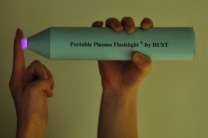Handheld plasma flashlight rids skin of notorious pathogens

(PhysOrg.com) -- A group of Chinese and Australian scientists have developed a handheld, battery-powered plasma-producing device that can rid skin of bacteria in an instant.
The device could be used in ambulance emergency calls, natural disaster sites, military combat operations and many other instances where treatment is required in remote locations.
The plasma flashlight, presented today, 5 April, in IOP Publishing's Journal of Physics D: Applied Physics is driven by a 12 V battery and doesn't require any external generator or wall power; it also doesn't require any external gas feed or handling system.
In the experiment, the plasma flashlight effectively inactivated a thick biofilm of one of the most antibiotic- and heat-resistant bacteria, Enterococcus faecalis – a bacterium which often infects the root canals during dental treatments.
The biofilms were created by incubating the bacteria for seven days. The biofilms were around 25 micrometres thick and consisted of 17 different layers of bacteria. Each one was treated for five minutes with the plasma flashlight and then analysed to see how much of the bacteria survived.
Results showed that the plasma not only inactivated the top layer of cells, but penetrated deep into the very bottom of the layers to kill the bacteria.
Co-author of the study, Professor Kostya (Ken) Ostrikov, from the Plasma Nanoscience Centre Australia, CSIRO Materials Science and Engineering, said: "The bacteria form thick biofilms, which makes them enormously resistant against inactivation which is extremely difficult to implement. High temperatures are commonly used but they would obviously burn our skin.
"In this study we chose an extreme example to demonstrate that the plasma flashlight can be very effective even at room temperature. For individual bacteria, the inactivation time could be just tens of seconds."
Plasma – the fourth state of matter in addition to solids, liquids and gases – has previously shown its worth in the medical industry by effectively killing bacteria and viruses on the surface of the skin and in water.
Although the exact mechanism behind the anti-bacterial effect of plasma is largely unknown, it is thought that reactions between the plasma and the air surrounding it create a cocktail of reactive species that are similar to the ones found in our own immune system.
The researchers ran an analysis to see what species were present in the plasma and found that highly-reactive nitrogen- and oxygen-related species dominated the results. Ultraviolet radiation has also been theorised as a reason behind plasma's success; however, this was shown to be low in the jet created by the plasma flashlight, adding to the safety aspect of the device.
The temperature of the plume of plasma in the experiments was between 20-230C, which is very close to room temperature and therefore prevents any damage to the skin. The device itself is fitted with resistors to stop it heating up and making it safe to touch.
"The device can be easily made and costs less than 100 US dollars to produce. Of course, some miniaturisation and engineering design may be needed to make it more appealing and ready for commercialisation," Ostrikov continued.
The device was created by an international team of researchers from Huazhong University of Science and Technology, CSIRO Materials Science and Engineering, The University of Sydney and the City University of Hong Kong.
More information: Inactivation of a 25.5 µm Enterococcus faecalis biofilm by a room-temperature, battery-operated, handheld air plasma jet, 2012 J. Phys. D: Appl. Phys. 45 165205. iopscience.iop.org/0022-3727/45/16/165205
Provided by Institute of Physics

















